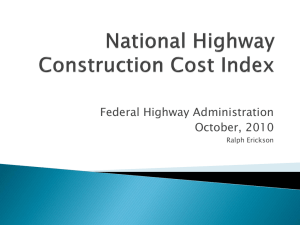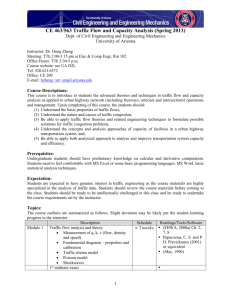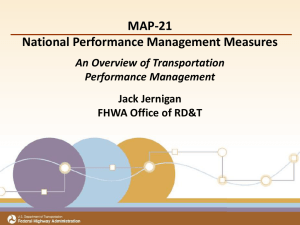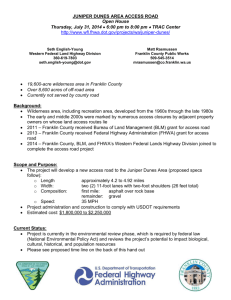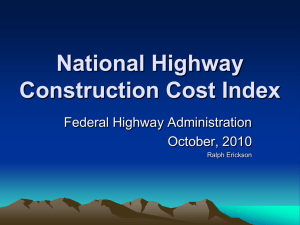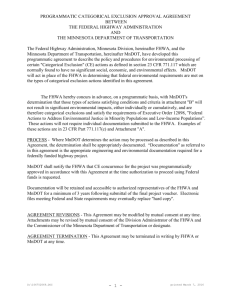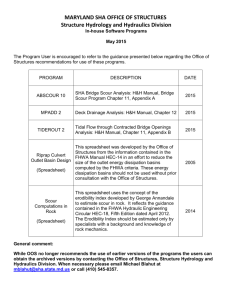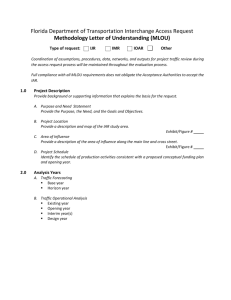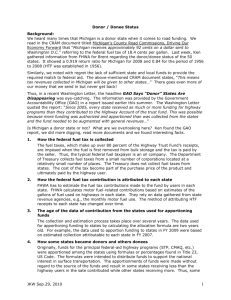04_Section_3
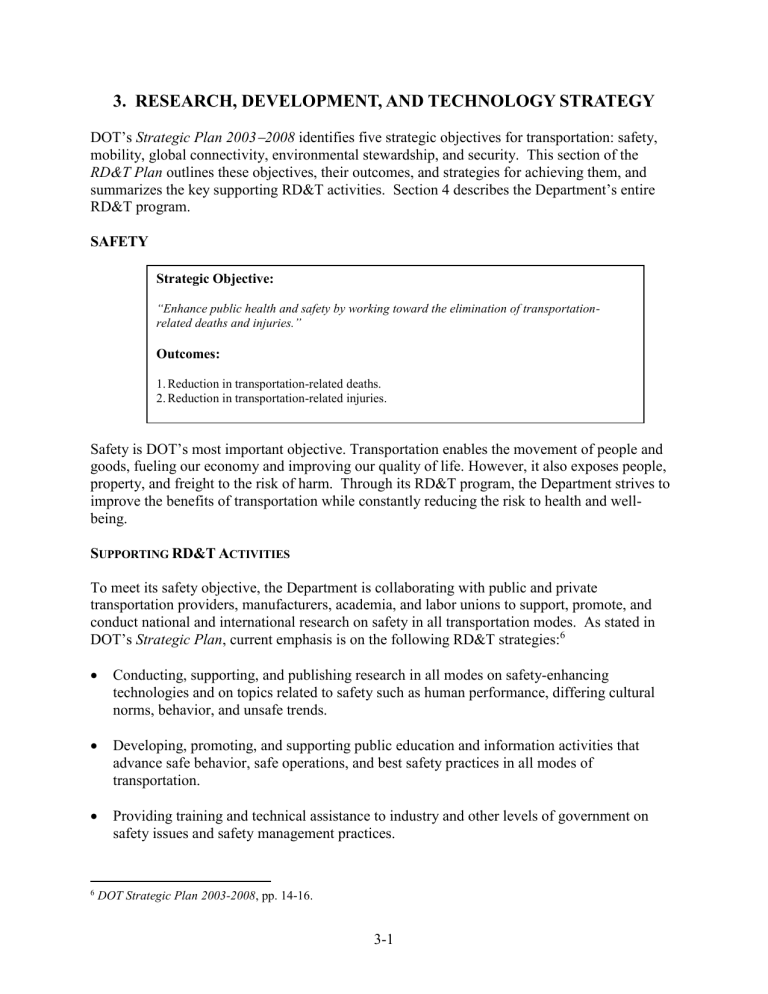
3. RESEARCH, DEVELOPMENT, AND TECHNOLOGY STRATEGY
DOT’s
Strategic Plan 2003
2008 identifies five strategic objectives for transportation: safety, mobility, global connectivity, environmental stewardship, and security. This section of the
RD&T Plan outlines these objectives, their outcomes, and strategies for achieving them, and summarizes the key supporting RD&T activities. Section 4 describes the Department’s entire
RD&T program.
SAFETY
Strategic Objective:
“Enhance public health and safety by working toward the elimination of transportationrelated deaths and injuries.”
Outcomes:
1.
Reduction in transportation-related deaths.
2.
Reduction in transportation-related injuries.
Safety is DOT’s most important objective. Transportation enables the movement of people and goods, fueling our economy and improving our quality of life. However, it also exposes people, property, and freight to the risk of harm. Through its RD&T program, the Department strives to improve the benefits of transportation while constantly reducing the risk to health and wellbeing.
S
UPPORTING
RD&T A
CTIVITIES
To meet its safety objective, the Department is collaborating with public and private transportation providers, manufacturers, academia, and labor unions to support, promote, and conduct national and international research on safety in all transportation modes. As stated in
DOT’s Strategic Plan , current emphasis is on the following RD&T strategies: 6
Conducting, supporting, and publishing research in all modes on safety-enhancing technologies and on topics related to safety such as human performance, differing cultural norms, behavior, and unsafe trends.
Developing, promoting, and supporting public education and information activities that advance safe behavior, safe operations, and best safety practices in all modes of transportation.
Providing training and technical assistance to industry and other levels of government on safety issues and safety management practices.
6 DOT Strategic Plan 2003-2008 , pp. 14-16.
3-1
Working with stakeholders to build safety into the transportation infrastructure and into operational procedures through research, planning, design, engineering, incentives, and incorporation of safety-enhancing technologies.
Mitigating the consequences of safety incidents through more effective response, technology, and coordination with private transportation providers and state and local government.
Capitalizing on secure, advanced technology to provide information to the public in languages and formats they understand on the benefits of safe behavior and practices in all modes of transportation.
Increasing the implementation of infrastructure and operational improvements focused on enhancing the ability of drivers to remain on the roadway, reducing the adverse consequences of roadway departure, improving intersection safety, and protecting pedestrians in the roadway environment.
The following are among the specific RD&T programs that support safety:
Aircraft Safety Program (FAA)
Provides a safe global air transportation system by establishing safety standards and acceptable practices through development of technical information, tools, and technology to ensure safe operation of the civil aircraft fleet. This program addresses the many hazards that face all aircraft, as well as special hazards that apply to select portions of the civil aircraft fleet.
Airport Safety Program (FAA)
Improves the safety of operations on the airport surface and in the immediate environs by conducting research to improve airport lighting, surface markings, and signage for improved operator situational awareness; to reduce wildlife hazards; and to improve airport fire and rescue capabilities. Further improvements to the safety of operations will be made through research on new surveillance systems to improve both pilot and air traffic controller situational awareness and to provide an alerting mechanism to avoid runway incursions.
Aviation Weather Program (FAA)
Improves the safety of flight operations by conducting research to provide more accurate weather observations, warnings, and forecasts; to more efficiently deliver these products to both pilots and air traffic controllers; and to make these products more accessible to pilots both on the ground and in the air. Better and more timely weather products should lead to increased situational awareness with regard to hazardous weather conditions and enhanced decision making.
3-2
Carrier Compliance and Safety (FMCSA)
Uses innovative and proactive techniques to ensure that motor carriers meet their responsibility for the safety of both their drivers and vehicles in compliance with carrier-related Federal Motor
Carrier Safety Regulations and Hazardous Materials Regulations. This research area also supports efforts to improve carrier safety by applying principles of safety management science from other industries and best management practices from the motor carrier and other industries.
Commercial Vehicle Information Systems and Networks [CVISN] (FMCSA/ITS JPO)
Develops and deploys cost-effective information systems and communication networks that provide electronic access to timely and accurate motor carrier safety and other information.
CVISN is a collection of information systems and communication networks that together provide a framework for states, the Federal Government, and private stakeholders to electronically collect, process, and exchange motor carrier safety information and commercial vehicle and driver data.
Commercial Vehicle Operations [CVO] (ITS JPO)
Supports DOT’s safety objective by developing and deploying Intelligent Transportation
Systems (ITS) technologies to enhance the safety of commercial vehicle operations. Activities include work on qualified driver systems, smart roadside operations to support safety enforcement, and compliance.
Commercial Vehicle Safety Performance (FMCSA, ITS JPO)
Focuses on improving truck and bus performance through vehicle-based safety technologies and developing new data and information to improve occupant protection and overall vehicle safety.
Crash Avoidance—Driver/Vehicle Performance (FMCSA, NHTSA)
Improves the capability of driver/vehicle systems to avoid crashes by improving vehicle performance, introducing collision avoidance systems, and making vehicles more compatible with the capabilities and behaviors of the driving population.
Cross-Modal Human Factors Research (DOT-wide)
Under the auspices of the Departmental Safety Council and Human Factors Coordinating
Committee, studies the interaction of humans with technology in challenging scenarios common to all transportation modes, such as those involving operators, operations controllers, and emergency responders. The program addresses such issues as fatigue and distraction, with the aim of developing operator fatigue management systems and of training people through simulation of real-life conditions found in transportation environments.
3-3
Crosscutting Safety Initiatives (FMCSA)
Consolidates information on driver, carrier, vehicle, and roadway environmental factors that place commercial motor vehicles at risk, and on the potential applicability of countermeasures; develops and fosters R&T partnerships with other organizations in the motor carrier safety community.
Driver Safety Performance (FMCSA)
Ensures that commercial drivers are physically qualified, trained to perform safely, and mentally alert; improves the safety behavior of non-commercial drivers in the vicinity of trucks and buses.
Driver, Vehicle, and Roadside Strategies for 2010 (FMCSA)
Supports research and testing of new technologies and operational concepts that will decrease commercial-vehicle-related fatalities and injuries and improve commercial motor carrier, vehicle, and driver safety and performance.
Grade Crossings—Sealed Corridor Initiative (FRA)
Improves grade crossing safety by promoting a comprehensive approach to crossing hazards on a total corridor basis through a joint railroad–state demonstration program that evaluates multiple solutions and the exploration of more opportunities for interlinking railroad signal systems, grade crossing protection, automatic train control systems, and highway applications.
Hazardous Materials Transportation Research (FRA)
Conducts research to help minimize the incident rate of leaks, spills, and damage to equipment and the environment due to hazardous materials releases from railroad tank cars. Research will also reduce the number of injuries and fatalities related to tank car accidents and incidents.
Heavy Vehicles (NHTSA)
Supports the NHTSA’s rulemaking and consumer information efforts by developing the scientific basis for improving the safety of heavy vehicles. Research aims to make these vehicles less prone to crashes by (1) improving their braking, handling, and visibility characteristics; and
(2) mitigating the consequences of collisions that do occur between heavy trucks and other vehicles.
Highway Safety Research (NHTSA)
Determines the causes of crashes, identifies target populations, and evaluates the effectiveness of laws, sanctions, and programs that will reduce traffic deaths, injuries, and associated monetary costs. The program provides the scientific basis for the NHTSA’s national leadership in vehicle and operator safety through studies of (1) driver, passenger, motorcyclist, and pedestrian
3-4
attitudes and behaviors; (2) the circumstances and situations of crashes; and (3) the most effective ways to reduce crashes.
Human-Centered Systems Research (FHWA)
Seeks to improve safety and enhance operations by addressing the needs of users of the highway transportation system. To ensure that operational changes are successful and that safety is continually improved, it is critical that driver and pedestrian capabilities be taken into consideration during roadway design, construction, repair, and improvement. Studies show that inappropriate driver perceptions and behaviors are implicated in 80 to 90 percent of highway crashes. Research includes examination of driver capabilities and limitations behind the wheel; exploration of factors affecting the performance of older drivers on the roadway; investigation of advanced traffic management strategies; and studies of driver visibility and performance for all roadway classifications and operating conditions, including bicycle paths, sidewalks and crosswalks, traffic control devices, and other safety countermeasures. The FHWA also participates in crossmodal DOT efforts.
Human Factors and Aviation Medicine (FAA)
Conducts applied research to identify methods, procedures, technology, and training to enhance human performance and thereby help reduce the fatal aviation accident rate. Project areas include human factors relating to air traffic services, commercial and general aviation flight decks, aircraft and airway facilities maintenance, and aeromedical research. The program ensures human factors issues are addressed in the acquisition and integration of FAA systems and applications.
Human Factors Research (FRA)
Conducts human factors research to focus on identifying root causes for repetitive human errors and developing effective countermeasures by targeting human factors in yards, terminals, control centers, and train operations for freight, intercity passenger, commuter, and highly automated high-speed passenger operations.
Intelligent Railroad Systems (FRA/FTA)
Uses sensors, computers, and digital communications to collect, process, and disseminate information to improve the safety and security of freight, intercity passenger, and commuter railroads. The FRA, FTA, and railroad industry are working on the development of Intelligent
Railroad Systems that would incorporate the new technologies into train control, braking systems, intelligent grade crossings, defect detection, intelligent weather systems, tactical and strategic planning systems, and travelers’ advisory systems. The human factors aspects of these new technologies are also being examined.
3-5
Intersection Safety (FHWA)
Seeks to improve intersection safety by reducing the number and severity of intersection-related crashes. Half of all highway crashes and 21 percent of highway fatalities are intersection-related.
Research efforts include developing analytical tools that utilize surrogate safety measures to identify intersection safety problems and evaluate performance of safety countermeasures, developing tools for improved dilemma zone protection at signalized intersections, and studying and developing the ability to predict performance of safety countermeasures.
ITS and Safety (FHWA/FTA/ITS JPO)
Incorporates technology that enhances traffic and incident management, thereby improving overall highway safety. ITS research focuses on helping drivers avoid crashes by helping them to detect hazards and take necessary preventative and defensive measures, and examines the development of vehicle technologies that can assume partial control of vehicles to avoid collisions. Safety-related ITS areas include the Intelligent Vehicle Initiative (IVI),
Infrastructure-Based Intersection Collision Avoidance Systems, Traveler Information Research, and Crash Prevention Research.
IVI (FHWA/FMCSA/FTA/ITS JPO/NHTSA)
Aims to prevent crashes by helping drivers avoid hazardous mistakes. Goals are to (1) prevent driver distraction, and (2) facilitate accelerated development and deployment of crash avoidance systems. Included are activities that will increase safety under normal driving conditions through the design of in-vehicle communication and information systems; in degraded driving conditions where the risk of a crash is increased; and in dangerous situations through crash avoidance.
National Center for Statistics and Analysis [NCSA] (NHTSA)
Collects, analyzes, and disseminates traffic crash data for government and public use. The
NCSA includes several core programs: the Fatality Analysis Reporting System, which provides a census of all fatal highway crashes in the United States; nationally representative motor vehicle crashworthiness data through the National Automotive Sampling System; the Motor Vehicle
Crash Causation Survey of nationally representative data on the causes of crashes; and the
Special Crash Investigations, a program that identifies and documents the effects of rapidly changing vehicle technologies to assess their impacts on motor vehicle crashes. In cooperation with the FMCSA, two other data collection programs—the Commercial Vehicle Analysis
Reporting System and the Large Truck Crash Causation Study—are providing data on motor vehicle crashes, including crash causation involving commercial motor vehicles.
National Transportation Biomechanics Research Center (NHTSA)
Uses the principles of engineering to study human injury mechanisms in vehicle crashes and to develop intervention and prevention strategies.
3-6
Pavement Research (FHWA)
Provides pavements that are safe, cost-effective, long-lasting, and easily maintained, and that meet customer needs. With over 13,000 fatality reports noting pavement as a contributing factor, the pavements program has been redirected to go beyond incremental improvements to developing and delivering breakthrough technologies and pavement systems that will radically improve the standards for pavement performance.
Pedestrian and Bike Safety (FHWA/NHTSA)
Focuses on identifying problem areas for pedestrians and bicycles, developing analytic tools that allow planners and engineers to better understand and target these problem areas, and evaluating countermeasures to reduce the number of crashes involving pedestrians and bicycles. On average, crashes involving pedestrians and bicyclists result in 15 percent of motor-vehiclerelated fatalities annually in the United States. Highlights include the study of conflicts between path users and motor vehicles at the intersections of shared-use paths and roadways, bicycle safety countermeasures, and pedestrian and bicycle crash analysis software.
Photometric and Visibility Research (FHWA)
Conducts research designed to enhance traffic control devices and improve visibility on and along the roadway. The program investigates the effectiveness of innovative means of marking, signing, signaling, and lighting through direct photometric or colorimetric measurements, and by supporting human-centered studies of the effectiveness of new technologies. In addition, the
Visibility program promotes opportunities that advance new practices and technologies to improve roadway visibility on a cost-effective basis.
Pipeline Safety Research (RSPA)
Enhances the safety and reduces the potential environmental impacts of transporting natural gas and hazardous liquids through pipelines. Activities address new technologies to reveal defects in pipelines that are currently unpiggable; to provide better detection, characterization, and control of stress corrosion cracking; and to develop pipeline materials that better withstand third-party damage, corrosion, and cracking.
Pneumatic Tire Research (NHTSA)
Supports rulemaking initiatives for upgrading existing tire standards and establishing a warning system in new motor vehicles to indicate when a tire is significantly underinflated.
Public Safety Program (ITS JPO)
Seeks to improve emergency response and reduce delay in rural and metropolitan areas through research and testing of new technologies and procedures for detecting, locating, and properly responding to highway incidents.
3-7
Railroad Systems Issues: Safety, Security, and Environment (FRA)
Conducts research to address system safety issues for freight, commuter, intercity passenger, and high-speed passenger railroads.
Roadway Departure (FHWA)
Emphasizes keeping vehicles on the roadway and minimizing the consequences of leaving the roadway. Single vehicle run-off-road crashes result in approximately one-third of all highway fatalities and 500,000 injuries annually, with a societal cost of $80 billion each year. Research includes enhanced driver visibility studies, improvement of crash barriers and other roadside hardware to keep vehicles on the roadway and prevent rollovers, and the development of the
Interactive Highway Safety Design Model, which will help highway planners and designers to assess the safety effects of specific geometric design decisions and provide alternative improvements for two-lane roads.
Rolling Stock and Components (FRA)
Conducts research to develop and improve rail equipment defect detection via wayside and onboard systems to reduce the number of derailments due to equipment failures. Also conducts research into improvements in equipment materials.
Runway Incursion Reduction Program (FAA)
Develops technologies and other solutions that minimize the chance of injury, death, and damage
(or loss of property) due to runway accidents or incidents within the civil aviation system.
Current program initiatives are aimed at discovering and developing technologies that increase pilot/controller situational awareness.
Safe Flight 21—Alaska Capstone Program (FAA)
Improves the safety of flight operations in Alaska through the introduction of new communications, navigation, and surveillance technologies. Capstone initiatives will provide weather, terrain, and traffic information; flight following and locating capabilities; Global
Positioning System (GPS) en-route, all-weather infrastructure and non-precision instrument approaches; and training for pilots with Capstone avionics.
Safety and Security (FTA)
Develops standards for alternative-fuel safety (e.g., hydrogen fuel cells) and technical guidance materials for the transit industry. Trains approximately 4,000 transit industry professionals in system safety, accident prevention and investigation, industrial safety, and bus operator safety.
Improves the detection and prevention of drug and alcohol use by transit operators and measures to deal with operator fatigue.
3-8
Safety Conscious Planning (FHWA/FMCSA/FTA/NHTSA)
Develops collaborative strategies to (1) integrate safety into the planning process, and (2) build analytical tools to support Metropolitan Planning Organizations (MPOs), state DOTs, and local governments. Research will identify institutional issues and barriers, along with potential solutions; collect data; and conduct spatial and statistical analyses.
Safety Management (FHWA)
Uses data from the Highway Safety Information System and other sources to understand how safety is affected by the geometric design of highways, the use of traffic control measures, the size and performance capabilities of vehicles, and the needs and abilities of users. Efforts are underway to develop a set of analytical tools for use in the highway safety improvement process.
Safety Systems (NHTSA)
Enhances occupant protection by providing improvements in vehicle structure and interior compartment design, in combination with improvements in occupant restraint systems.
Speed Management (FHWA)
Focuses on developing and testing engineering measures and technologies to manage speeds; assessing the changing conditions that necessitate changed speeds; and conducting behavioral studies to encourage wider adoption of travel speeds appropriate for the class of road, roadway design, and travel conditions. Speed management is a complex issue involving engineering, environmental, and behavioral factors.
Structures Research (FHWA)
Provides highway managers and engineers with information and tools to design, build, and maintain safer and better performing infrastructure assets. The program encompasses new techniques to reduce damage and prevent structural collapse of bridges caused by corrosion and natural hazards, and applies non-destructive evaluation techniques to measure structural integrity and cumulative fatigue loading. Other research focuses on improving the longevity of new or replacement construction through variations of the more familiar construction materials—such as steel and concrete—and more exotic materials—including fiber-reinforced polymer composites and aluminum. Finally, bridge asset management strategies will help to accurately assess the nation’s huge inventory of bridges and determine which are structurally deficient or functionally obsolete.
Track and Structures Safety Research Program (FRA)
Conducts research on advanced inspection technologies to detect track hazards well before accidents can occur and to evaluate the safe load capacity and structural integrity of bridges.
3-9
Train Occupant Protection (FRA)
Focuses research on the structural crashworthiness and interior safety of intercity and commuter passenger rail cars and locomotives to improve the survivability of rail passengers and crewmembers in accidents. Fire safety and emergency response issues are also addressed.
Training and Technology Transfer (FHWA)
Provides training and technical assistance to promote the application of technologies and to help maintain high levels of technical competence. FHWA programs such as the National Highway
Institute (NHI) and Local Technical Assistance Program (LTAP) are important tools for education and training in support of safety and other agency goals.
MOBILITY
Strategic Objective:
“Advance accessible, efficient, intermodal transportation for the movement of people and goods.”
Outcomes :
1.
Improved infrastructure in all modes.
2.
Reduced congestion in all modes.
3.
Increased reliability throughout the system.
4.
Increased access for all Americans.
Mobility, as much as any other factor, defines us as a nation, and is intertwined with our economic growth. The U.S. transportation system connects people with work, school, community services, markets, and other people. It carries over 4.6 trillion passenger-miles of travel and 3.9 trillion ton-miles of freight every year—generated by more than 260 million people and 6 million businesses. DOT’s aim is an affordable, reliable, and accessible transportation system. Among the objectives of RD&T is to optimize investment in these public systems and maximize their benefit to all Americans.
S UPPORTING RD&T A CTIVITIES
The Department is expanding alliances with a range of public and private stakeholders in all modes to meet its mobility objective and outcomes. The Strategic Plan 2003-2008 identifies the following overarching RD&T strategies: 7
Exploiting web-enabled and other secure information technologies to update contingency planning, to speed response and restoration actions, to communicate emerging mobility issues, and to share information on best practices in improving mobility in all modes.
7
ibid., pp. 24-26.
3-10
Examining ways to encourage cargo movements by water to bring improved capacity to our intermodal transportation system.
In consultation with our public and private sector partners, conducting research and expediting the deployment of technologies, as well as innovative operation and service concepts, that improve the reliability and efficiency of the system and the durability of the infrastructure.
Providing technical assistance and training to improve transportation planning and effective management and operation of the system.
Supporting programs are as follows:
Advanced Traffic Signal Control Systems (FHWA)
Develops and tests improved adaptive control systems and accelerates the deployment of current systems. Develops and validates improved traffic analysis tools, such as the Next Generation
Traffic Simulation core algorithms.
Airport Technology Program (FAA)
Provides enhancements in airport system efficiency through airport planning and design advancements, and airport pavement design, construction, and maintenance improvements.
Bridge Research and Construction (FHWA)
Examines the material properties of High-Performance Concrete, High-Performance Steel
(HPS), and Advanced Composite Materials to determine the necessary material changes for innovative uses. Evaluates new methods for load testing foundation systems and sponsors national workshops on HPS bridges and Load Factor Resistance Design. Under the Innovative
Bridge Research and Construction Program, provides funding to state DOTs for construction of bridges using innovative designs and materials.
Center for Advanced Aviation System Development (FAA)
Provides new technology research for applications in global air traffic management, including developments in aircraft traffic flow management, navigation, communications, separation assurance, security, surveillance technology, and system safety.
Congestion Relief (OST)
Seeks to improve the Department’s ability to provide better customer service to cities, counties, and regions grappling with the need to ease traffic congestion, reduce air pollution, and use transportation more effectively in serving economic growth. DOT headquarters and field staff from all modes collaborate to ensure the success of this effort.
3-11
Enhanced Work Zone Traffic Management (FHWA)
Develops expanded, automated reporting of work zone presence; integrated scheduling of construction, maintenance, and utility work with other departments and agencies; information on work zone presence and conditions that is communicated to travelers; and techniques for better managing traffic in work zones.
Environment and Energy (FAA)
A cohesive portfolio of research projects, supports Federal actions to identify, control, and mitigate the environmental consequences of aviation activity. Through an optimal mix of aircraft noise and aviation–exhaust emissions certification standards, operational procedures, compatible land use, and abatement technology, research seeks to minimize the global, regional, and local impact of aircraft noise and exhaust emissions, sustaining aviation growth and ensuring mobility.
Fleet Operations (FTA)
Assists in the deployment of Bus Rapid Transit demonstration projects and their documentation and evaluation.
Forecasting Transport Demand and System Changes (FHWA)
Delivers integrated planning analysis capabilities that can (1) evaluate the mobility, productivity, and human and natural environment outcomes of future transport system scenarios; (2) satisfy planning analysis requirements; and (3) meet the diverse needs of state DOTs and transportation planning professionals. The Travel Model Improvement Program is a cornerstone of this effort.
Likewise, the Transportation Analysis and Simulation System provides an integrated set of tools designed to give the transportation planning community accurate and complete information on travel demand, traffic impacts, congestion, and pollution.
Intelligent Railroad Systems (FRA/FTA)
Uses sensors, computers, and digital communications to collect, process, and disseminate information to improve the operational effectiveness of railroads. The FRA, FTA, and railroad industry are working on the development of Intelligent Railroad Systems that would incorporate the new technologies into train control, braking systems, intelligent grade crossings, defect detection, intelligent weather systems, tactical and strategic planning systems, and travelers’ advisory systems. The human factors aspects of these new technologies are also being examined.
ITS (FHWA/FMCSA/FTA/ITS JPO)
Applies advances in communication, navigation, sensor, and information-processing technologies to extend the capacity of the existing infrastructure through freeway management, traffic signal control, electronic toll collection, transit management, and other advances. Current
3-12
strategies focus on deploying the ITS infrastructure, completing key initiatives, and investing in tools that will increase system capacity. Highlights include the IVI—which uses enabling technologies to accelerate the development, availability, and widespread use of vehicle-based autonomous and infrastructure-cooperative systems that help drivers operate more safely and effectively—and rural technologies research—which applies ITS technology to rural settings.
Long Life Pavement Program (FHWA)
Seeks to provide pavements that are safe, cost-effective, long-lasting, and easily maintained.
Develops advanced pavement design systems that work with and enhance the new American
Association of State Highway and Transportation Officials (AASHTO) design guide; develops new models for the next generation design guide; and encourages the broad use of life-cycle cost analyses in the pavement design process. The program will develop advanced quality systems to optimize performance, reduce cost and risk in warranty contracts, establish optimal pavement quality standards, and develop the next generation of pavement evaluation tools. Construction procedures that minimize disruption and lane closures will enhance user satisfaction, and improved pavement smoothness and optimal surface texture will increase safety and reduce noise. Finally, the program will enhance the technical capability of the pavement work force by developing and providing training in current and new technologies; accreditation tools and criteria for testing laboratories; and a web-based information system for training, problem solving, and query response.
Metropolitan and Rural Policy Development (FTA)
Conducts research into social and economic issues that impact local and national transit policy, including the demographic and economic bases of demand for transit to improve determination of infrastructure and service needs; quantification of the benefits of transit; and the relationship between transit and land use.
Nationwide Differential GPS [NDGPS] (FHWA/FRA)
An augmentation of GPS, provides 1- to 3-meter positioning accuracy to receivers capable of receiving the differential correction signal. The NDGPS is an expansion of the U.S. Coast
Guard’s Maritime DGPS network and makes use of decommissioned Air Force Ground Wave
Emergency Network sites to calculate and broadcast the differential correction signals. The
NDGPS, which also provides integrity monitoring of the GPS constellation, will serve as the positioning system for railroad positive train control systems, road departure warning systems, and the national mayday system. It is now operational on more than 85 percent of the land area of the United States. Full operational capability, with dual-redundant coverage throughout the continental United States, will be available by 2008. To ensure continuity, accuracy, and reliability, the NDGPS is managed and monitored 24 hours a day, 7 days a week, from the U.S.
Coast Guard’s Master Control Stations at Alexandria, Virginia, and Petaluma, California.
NDGPS signals are available to any user who acquires the proper receiver, and there is no user fee. High-Accuracy NDGPS, providing 10-20-centimeter positioning accuracy, has been successfully tested at the Hagerstown, Maryland, NDGPS site.
3-13
National Intelligent Transportation Infrastructure [NITI] (FHWA/FMCSA/FTA/ITS JPO)
Seeks to deploy an integrated NITI across the United States within the next decade. A communication and information “backbone,” the NITI refers to the integrated ITS elements that will enable the surface transportation system to be managed as a seamless entity. Key components are the Metropolitan ITS Infrastructure Program Area, the Rural and Statewide ITS
Infrastructure Program Area, and the Commercial Vehicle ITS Infrastructure Program Area. In this last area, CVISN develops and deploys cost-effective information systems and communication networks that provide electronic access to timely and accurate motor carrier safety and other information. CVISN is a collection of information systems and communication networks that together provide a framework for states, the Federal Government, and private stakeholders to electronically collect, process, and exchange motor carrier safety information and commercial vehicle and driver data.
Next Generation High-Speed Rail Technology Demonstration Program (FRA)
Seeks to demonstrate technology that will facilitate the incremental development of high-speed rail passenger service to improve mobility between major urban areas.
Planning and Project Development (FTA)
Assists state and local transit planners in their planning process for creation and expansion of transit infrastructure and services. Activities include research on job access planning, performance of environmental and social impact studies, and financial planning.
Planning, Environment, and Realty (FHWA/FTA)
Ensures that transportation land use and development decisions are addressed in a comprehensive intermodal and multimodal planning process that supports the integration of planning and management of real property with environmental concerns. This research helps decision makers to identify solutions to address economic, social, environmental, land use, and technical developments, and provides capacity-building tools to state, metropolitan, rural, and tribal institutions to plan and fund transportation investments and operations.
Policy Research (FHWA)
Using information on economics, demographics, highway travel, and spending trends, provides unique and crucial analyses of the interrelationships among highway programs, systems, services, and institutional relationships. These analyses provide a framework for assessing the stewardship of the nation’s highways as a component of the overall transportation system.
Research takes place in four primary focus areas: (1) improving the collection and dissemination of core data concerning facilities and highway users; (2) developing analytical tools to evaluate the impacts of a broad range of highway policy options; (3) analyzing short-term and long-term issues that will affect surface transportation programs; and (4) identifying legislative and strategic initiatives to address these issues.
3-14
Regional and Corridor Traffic Management (FHWA)
Enhances mobility on highway and freeway facilities through research focusing on topics such as interagency coordination, cooperative traffic control strategies, and the use of analytic tools to develop and evaluate strategies at the regional and corridor level.
Safe Flight 21—Ohio River Valley Program (FAA)
A government/industry initiative, demonstrates and validates, in an operational environment, the capabilities of advanced communications, navigation, surveillance, and air traffic procedures designed to increase the capacity and efficiency of the nation’s aviation system.
Specialized Customer Services (FTA)
Seeks to ensure a transportation system that is accessible, integrated, and efficient; offers flexibility of choice; and enhances community living. Activities are designed to improve services tailored for elderly persons, low-income persons, and persons with disabilities.
Systems Management and Operations (FHWA)
Supports the DOT and FHWA objectives of enhancing safety, mobility, and environmental stewardship. The program conducts long-term and applied research to develop advanced tools and strategies to aid the secure operation of the surface transportation system, and enable efficient response and recovery time during security emergencies, while enhancing day-to-day operations.
Traffic Management (FHWA)
Supports the DOT and FHWA objectives of enhancing safety, mobility, and environmental stewardship through long-term and applied research to develop advanced tools (models, software, guidance documents) that practitioners can use to improve the management and control of traffic.
Training and Technology Transfer (FHWA)
Provides training and technical assistance to promote the application of technology and help maintain high levels of technical competence. FHWA programs such as the National Highway
Institute and Local Technical Assistance Program are important tools for education and training in support of agency strategic goals.
Transportation, Economic, and Land Use System (FHWA)
Helps MPOs and state DOTs prepare annual transportation improvement programs and carry out other Federally mandated planning responsibilities through a fully integrated information management and decision-support system. Information management features allow user customization, establishment of system security levels, tracking of project revisions and funding,
3-15
project scheduling, project querying, Geographic Information System (GIS) interface, and creation of 11 preformatted reports. Decision-support features include a Project Scoring Module,
Project Interrelationships Module, Planning Analysis Module, Economic (Input-Output) Module, and Land-Use Module.
Transportation Policy and Planning (OST)
Supports rulemaking activities to fulfill the Department’s obligation to improve access to various modes of travel by persons with disabilities under various statutes, primarily the Air Carrier
Access Act and the Americans with Disabilities Act. Supports and coordinates the development of policies to assure safe transportation for the coming surge in the number of older Americans.
Transportation Systems Management (ITS JPO)
Consists of five specific activities: (1) the Advanced Data Collection program, which develops advanced techniques and technologies for monitoring the surface transportation system; (2) the
Data Management program, which develops techniques and guidance for processing and managing the large amounts of data associated with highway and transit monitoring; (3) the
Telecommunications program, which conducts research and develops guidance to overcome the communications limitations for ITS applications in rural areas and for other key applications,
(such as monitoring critical infrastructure); (4) the Weather Network program, which develops specifications for weather sensor equipment and guidance for transportation agencies deploying weather sensor networks; and (5) the Data Dissemination program, which develops guidance for exchanging information about transportation services in near-real-time and providing that information to travelers.
Vehicle–Highway Automation (FHWA)
Uses vehicle-based or infrastructure-cooperative advanced control and safety systems to solve mobility issues. The program will focus on opportunities for vehicle automation to reduce congestion and improve the productivity and efficiency of bus fleets, motor carriers, and other freight operations. Crosscutting research will look at issues such as architecture, human factors, benefits, communications, and standards associated with vehicle–highway automation.
GLOBAL CONNECTIVITY
Strategic Objective:
“Facilitate a more efficient domestic and global transportation system that enables economic growth and development.”
Outcomes:
1.
Reduced barriers to trade in transportation goods and services.
2.
More efficient movement of cargo throughout the supply chain.
3.
Enhanced international competitiveness of U.S. transport providers and manufacturers.
4.
Harmonized and standardized regulatory and facilitation requirements.
5.
The most competitive, cost-effective, and efficient environment for passenger travel.
6.
Expanded opportunities for all businesses, especially small, women-owned, and disadvantaged businesses.
3-16
Transportation systems within and among nations have become lifelines to the future, to economic growth, to freer trade, and to greater cultural exchange. Our increasingly global economy hinges on smooth supply chains and just-in-time manufacturing. Transportation is critical to both. With leaner inventories, companies depend on transportation being efficient enough to give them a competitive edge.
S
UPPORTING
RD&T A
CTIVITIES
A domestic and international intermodal approach is central to DOT’s role in promoting global connectivity. As identified in the Strategic Plan , the following are among the key RD&T strategies:
8
Encouraging and facilitating intermodal transportation planning worldwide.
Supporting and conducting research on issues concerning the intersection of passenger and freight transportation.
Accelerating the use of technologies such as ITS that reduce travel time delays at key intermodal transfer points, in significant corridors, and at international border crossings.
The following programs support the Department’s RD&T strategies for global connectivity:
Border Planning (FHWA)
Leads coordination activities with the U.S./Canada Transportation Border Working Group and the U.S./Mexico Joint Working Committee to address infrastructure needs, promote effective communication among countries, and enhance land transportation at the border. Research in the area of border planning is geared toward improving the planning process with respect to our national borders with Canada and Mexico. Issues range from alleviating congestion and bottlenecks at border crossings to coordinating joint solutions with other Federal, state, and binational agencies. Additional areas of emphasis include identifying critical infrastructure and enhancing border security. Border planning research encourages and facilitates crossjurisdictional analysis, modeling, and opportunities for training and information sharing.
Freight Management (FHWA)
Increases the efficiency of intermodal freight movement over the nation’s highways, railroads, waterways, and ports. Work will engage major freight stakeholders in deploying technologies, improve modeling tools to increase mobility, and continue to develop standards for freight information exchange.
8 ibid., pp. 35-37.
3-17
Intermodal Freight Improvements (FHWA/OST)
Studies the physical condition of, and investment requirements for, transportation facilities that connect freight terminals to main routes. With concerns that these facilities are below passenger transport facility standards, causes for disparities will be analyzed and solutions proposed to improve planning and financing of freight access facilities. The full public costs and local benefits of freight systems will be studied, along with related payments of public user charges and taxes.
International Technology Scanning Program (FHWA)
Assesses and evaluates foreign-developed technologies and innovations that could significantly benefit U.S. transportation. The process and findings generally complement and enhance the existing knowledge base in the U.S. highway community, often putting innovations on the fast track to deployment in the United States. This program enables advanced technology to be adapted and implemented more efficiently, without spending scarce research funds to recreate technologies developed by other countries.
ITS (FHWA/FMCSA/FTA/ITS JPO)
Applies advances in communication, navigation, sensor, and information-processing technologies to extend the capacity of the existing infrastructure through freeway management, traffic signal control, electronic toll collection, transit management, and other advances.
ENVIRONMENTAL STEWARDSHIP
Strategic Objective :
“ Promote transportation solutions that enhance communities and protect the natural and built environment
.”
Outcomes :
1.
Reduced pollution and other adverse environmental effects of transportation and transportation facilities.
2.
Streamlined environmental review of transportation infrastructure projects.
Current trends in transportation are exerting pressure on environmental resources worldwide. In the United States, commercial and personal travel has grown substantially in recent years and will continue to increase in the future. Americans want solutions to transportation problems, but they want solutions that are consistent with sound environmental planning.
3-18
S
UPPORTING
RD&T
ACTIVITIES
DOT’s Strategic Plan calls for a balance between environmental challenges and the need for a safe and efficient transportation network. Among the RD&T strategies for achieving this vision are:
9
Supporting the President’s Hydrogen Fuel Initiative through research on fuel distribution and delivery infrastructure, transportation of associated hazardous materials, and vehicle safety.
Supporting interdisciplinary research on connections among transportation, energy, and the environment.
Adopting transportation policies and promoting technologies that reduce or eliminate environmental degradation.
Collaborating with Federal agencies and the private sector to support and conduct research on technologies that improve energy efficiency, foster the use of alternative fuels, and reduce vehicle emissions.
Working with transportation partners to mitigate the adverse environmental effects that presently occur from existing transportation systems.
The following RD&T activities support the environmental objective and strategies:
Air Quality (FHWA)
Conducts and disseminates research on particulates, air toxins, transportation emissions, energy and global climate change, congestion mitigation and air quality effectiveness, and rural air quality. Support for air quality and climate research will advance our understanding of the relationship of surface transportation to the emerging issues of fine particulate emissions, toxic air emissions, and regional haze. This knowledge will help the transportation community to develop mitigation tools and technologies to reduce fine particulate emissions. Air quality research develops analytical techniques and cost-effective mitigation strategies to reduce transportation-related emissions and permit development of viable transportation programs. This research is critical for the transportation community to assist Congress in assessing transportation’s contributions to air quality improvement.
Context-Sensitive Solutions and Context-Sensitive Design (FHWA)
Recognizes the need to plan, design, and operate transportation facilities and services within the context of the linkages among transportation systems and other factors defining the quality of life. This initiative will conduct research, develop performance measures for livability, develop tools and methods, and provide educational materials to inform the public of livability issues.
Work will identify techniques to show how transportation projects enhance communities,
9 ibid., pp. 45-47.
3-19
increase societal benefits, and encourage creative solutions and context-sensitive design—while meeting the goals of community residents and businesses.
Crosscutting Environmental Issues (OST/DOT-wide)
Supports environmental research of interest to more than a single transportation mode. The DOT
Center for Climate Change and Environmental Forecasting is a collaborative effort within DOT dedicated to fostering awareness of potential links between transportation and global climate change and to formulating policy options to deal with the challenges of these links. The OST and administrations also cooperate on other issues related to reducing and understanding the effects of transportation on the environment, such as air and water quality, noise, habitat and species, and land use.
Environment and Energy (FAA)
Mitigates the impacts of aircraft noise and aviation emissions and sustains aviation traffic growth through a coordinated research approach involving DOT and other Federal agencies in all project stages. The long-term strategy is to maintain the world’s premier noise, emissions, economic analysis, and societal aviation environmental impact models. The program seeks to develop an integrated Environmental Design Tool—which considers the tradeoffs between noise and emissions and among emissions—and a Portfolio Management Tool—to inform policy decisions and maintain the efficiency of the air system. These tools are critical in international forums for optimization and harmonization of policies and standards.
Environmental Stewardship and Streamlining (FHWA)
Identifies and develops time-sensitive, cost-effective techniques to redesign, integrate, and balance environmental and transportation decision making at the Federal, state, tribal, and local levels to help achieve the best overall public interest decisions. Key elements include full deployment of environmental streamlining; performance evaluation; and showcasing methods and examples of collaborative, integrated decision-making processes that have been successfully applied to transportation planning and project development.
Equipment and Infrastructure (FTA)
Works to accelerate the commercial introduction of low-emission, high-efficiency vehicles to the transit industry.
High-Speed Turbine-Electric Locomotive Technology (FRA)
Seeks to develop and demonstrate a high-speed, light-weight turbine-powered locomotive that achieves the speed and acceleration capability of electric locomotives without the expensive infrastructure of railroad electrification. The program is also developing an energy-storage flywheel device to be used with the high-speed turbine-powered locomotive.
3-20
Human and Natural Environment (FHWA)
Focuses on determining how transportation projects might impact the community, the natural environment, and our health and welfare. Research helps balance the community and social benefits of highway transportation and improves the quality of the natural environment by reducing highway-related pollution and by protecting and enhancing ecosystems. Human environmental research supports the built environment, transportation enhancements, community programs, and public involvement. Natural environmental research addresses noise model enhancement, air quality and climate change, wetlands, water quality, and ecosystems.
Hydrogen Fuels R&D (RSPA)
As part of the President’s Hydrogen Fuel Initiative, conducts RD&T on the safe handling and transport of large quantities of hydrogen fuel, and on the safety of onboard hydrogen vehicle power and storage systems. This effort supports the development of fuel-cell vehicles, direct hydrogen-fueled vehicles, and other alternative-fuel vehicles as a safe alternative to petroleumfueled vehicles—ultimately leading to increased fuel economy and decreased foreign petroleum dependence.
Locomotive R&D (FRA)
Enhances the environmental friendliness of the railroad industry by transferring promising fuel and engine technology and advancing specific innovations that show exceptional efficiency and environmental benefits.
Pavement Research (FHWA)
Assesses the environmental impact of construction and repair materials on surface and ground waters. This effort is part of a much broader Pavement Research R&D program.
Planning, Environment, and Realty (FHWA/FTA)
Ensures that transportation land use and development decisions are addressed in a comprehensive intermodal and multimodal planning process that supports the integration of planning and management of real property with environmental concerns. This research also helps decision makers to identify solutions to address economic, social, environmental, land use, and technical developments, and provides capacity-building tools to state, metropolitan, rural, and tribal planning institutions.
Surface Transportation Environment and Planning (STEP) Cooperative Research (FHWA)
Supports the nation’s growth and helps to meet public expectations for an improved transportation system. Research in this public–private program focuses on major multiyear initiatives to advance knowledge and understanding of complex transportation–environment topics, such as (1) human health; (2) ecology and natural systems; (3) environmental and social justice; (4) emerging technologies; (5) land use; (6) planning and performance measures; and (7) additional priorities.
3-21
Transportation, Economic, and Land Use System (FHWA)
Helps MPOs and state DOTs prepare annual transportation improvement programs and carry out other Federally mandated planning responsibilities through a fully integrated information management and decision-support system. Information management features allow user customization, establishment of system security levels, tracking of project revisions and funding, project scheduling, project querying, GIS interface, and creation of 11 preformatted reports.
Decision support features include a Project Scoring Module, Project Interrelationships Model,
Planning Analysis Module, Economic (Input-Output) Module, and Land-Use Module.
SECURITY
Strategic Objective :
“Balance homeland and national security transportation requirements with the mobility needs of the nation for personal travel and commerce.”
Strategic Outcomes:
1.
Rapid recovery of transportation in all modes from intentional harm and natural disasters.
2.
A U.S. transportation system that meets national security requirements.
Transportation security is equal in importance to transportation safety. As we have witnessed, the nation’s transportation system has certain vulnerabilities, which need to be guarded against attack, and our borders are subject to illegal intrusions by smugglers of contraband or weapons of mass destruction, and by illegal migrants. DOT’s objective is to contribute to security by working with the Department of Homeland Security (DHS), other Federal agencies, state and local governments, the private sector, and citizens to minimize transportation’s vulnerability to disruption, damage, or exploitation through crime or terrorism.
S
UPPORTING
RD&T A
CTIVITIES
In its Strategic Plan 2003-2008 , DOT identifies strategies for working with DHS and state, local, and private sector partners to elevate transportation security levels while improving the network’s safety and efficiency. Among the RD&T strategies are: 10
Monitoring the transportation system 24/7 to provide real-time reports and to help ensure rapid response and recovery from disruptions to transportation throughout the nation.
Implementing cybersecurity programs to adequately protect DOT systems integrated with the national critical infrastructure.
10 ibid., pp. 52-53.
3-22
Employing advancements in secure, certified, and accredited IT technology and communications to improve the accuracy, speed, and simplicity of exchanging security, emergency response, and defense deployment information with Federal, state, and local governments and the private sector.
In meeting its security objective and strategies, DOT conducts the following RD&T activities:
Emergency Preparedness (FHWA)
Works cooperatively with key Federal, state, and local partners to ensure mobility in the event of emergencies. The goal is to return highways to full service following disasters as soon as possible and to optimize the operation of highways during the disaster to facilitate evacuations and the movement of relief material and personnel. Principal partners include the Department of
Defense (DOD), DHS, state DOTs, and security and emergency transportation offices within
DOT. In addition, as part of its research on the effects of adverse weather on traffic operations, the FHWA will identify issues and mitigating strategies. This research will also look into the issues related to evacuations due to natural and man-made disasters. Finally, the FHWA will study the use of a web-based GIS to provide road closure information to the military for homeland security. The system would provide road closure information on all parts of the
National Highway System (NHS) in case of national emergency, severe weather, or disaster.
FHWA Research with Implications for National Security (FHWA)
Examines FHWA projects that have potential application for national security issues. The
FHWA will examine projects as they relate to system integrity and protection, evacuations, and emergency management. Concepts include ensuring the safety, reliability, and security of bridges; improving anti-ram barriers; and developing an “infostructure” to facilitate emergency management. The FHWA also will participate in pooled-fund studies in the areas of Rapid
Bridge Replacement and Bridge Design, Construction, and Retrofit Strategies, and is leading an additional pooled-fund study on State-of-the-Art Bridge Surveillance Technologies. These topics were identified as having high priority by AASHTO’s Transportation Security Task Force
(see Section 5). The FHWA is cooperating with the U.S. Army Corps of Engineers to adapt engineering tools for blast analysis for use on typical highway structures. Finally, the FHWA plans to conduct workshops to bring together experts on highway structures and security to define long-range research needs for securing our highways, bridges, and tunnels, with the objective of developing a 5- to 10-year infrastructure security research program.
GPS Vulnerability (FAA/OST)
Enhances the protection of the GPS from intentional or unintentional interference by (1) upgrading the FAA’s Radio Frequency Interference (RFI) direction-finding equipment at fixed monitoring sites, on flight inspection aircraft, on regional RFI vans, and on portable RFI equipment; and (2) protecting the spectrum status of the GPS L1 band (1559–1610 MHz). In addition, this effort has proposed a study on establishing a National Airspace System
Interference, Detection, Location, and Mitigation Program. Such a program would meet air
3-23
traffic requirements to resolve interference to any FAA communication, navigation, or surveillance system.
Integrated Transportation Analysis Vulnerability Assessment (FHWA)
Seeks to develop a vulnerability assessment system for the transportation network, from state transportation departments to local communities. This will be a tool to better understand how transportation impacts, and is impacted by, other systems that are vital to the nation’s well-being, as well as how to respond to emergency situations.
ITS Security Research (FHWA/FMCSA/ITS JPO)
Focuses on the development and integration of ITS technologies that enhance the security of our transportation systems. This activity consists of four specific programs. The Freight Program is designed to help ensure the security of the transportation system for the movement of goods while maintaining industry productivity and the nation’s trade competitiveness. The CVO program will enhance the ability to track commercial vehicle routes, verify commercial drivers who are operating trucks, monitor the movement of stolen commercial vehicles, and improve
CVO productivity and security. The Passenger Security Research program will enhance safety and security and increase the ability to track the location of transit vehicles, verify drivers and passengers, screen baggage, detect weapons and hazardous materials, and provide surveillance and emergency alarms. Last, the System Management and Operations program will develop advanced tools and strategies to aid the secure operation of the surface transportation system, and enable efficient response and recovery time during security emergencies, while enhancing dayto-day operations.
Safety and Security (FTA)
Seeks to improve the state of transit readiness for potential terrorist attacks, with particular focus on security training, public awareness, and emergency preparedness practice drills. Includes design standards, testing, and validation of security technologies that can be transitioned quickly into a transit environment, particularly technologies that will help prevent, reduce the impact of, and enhance the recovery from terrorist attacks.
Strategic Highway Network [STRAHNET] (FHWA)
Focuses on data management and analysis of 61,044 miles of the NHS. The STRAHNET includes the 45,376-mile Interstate system; 15,668 miles of non-Interstate highways; and approximately 1,700 miles of additional roadways (STRAHNET connectors) that connect military bases to the NHS. The FHWA maintains and examines national data on the condition of roads and bridges, including the STRAHNET and STRAHNET connectors, and provides this information to DOD’s Military Traffic Management Command Transportation Engineering
Agency to support its national defense strategies.
3-24
Truck and Bus Security (FMCSA)
Assesses truck and bus susceptibility to negative consequences from potential threats; develops mitigation strategies and technological solutions for protecting drivers, staff, passengers, and the general public.
3-25
